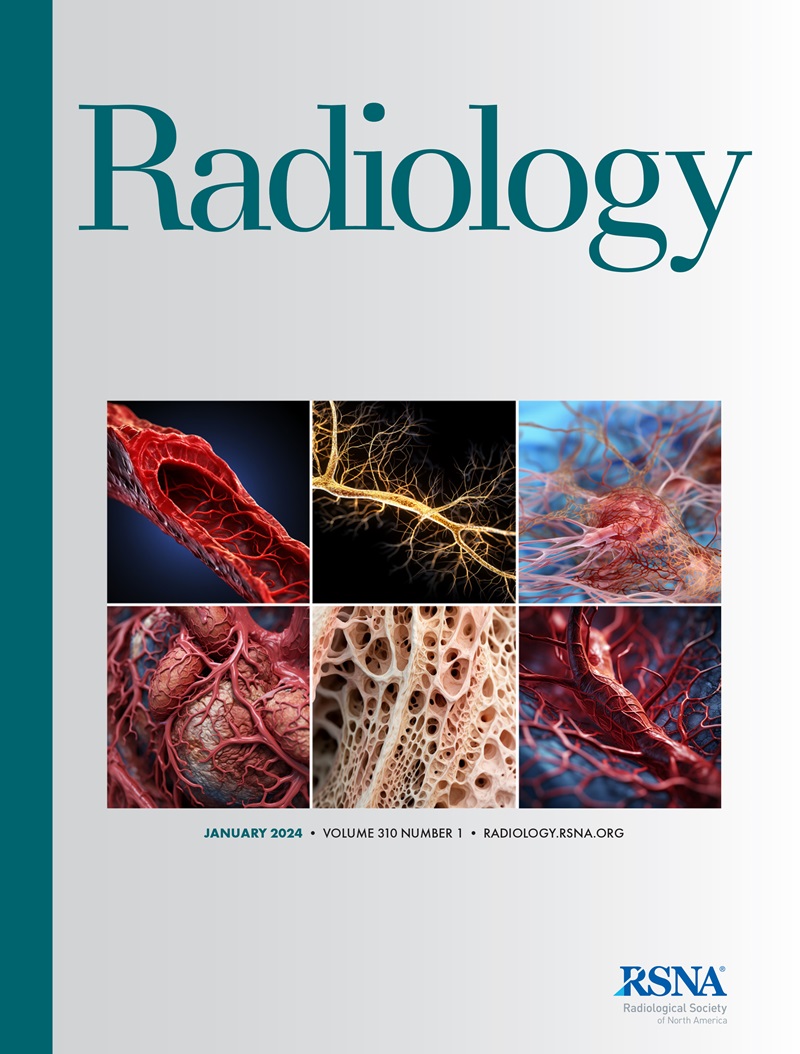求助PDF
{"title":"北欧非吸烟人群中按年龄和性别划分的实体肺结节存在和大小分布情况","authors":"Jiali Cai, Marleen Vonder, Gert Jan Pelgrim, Mieneke Rook, Gerdien Kramer, Harry J M Groen, Geertruida H de Bock, Rozemarijn Vliegenthart","doi":"10.1148/radiol.231436","DOIUrl":null,"url":null,"abstract":"<p><p>Background Most of the data regarding prevalence and size distribution of solid lung nodules originates from lung cancer screening studies that target high-risk populations or from Asian general cohorts. In recent years, the identification of lung nodules in non-high-risk populations, scanned for clinical indications, has increased. However, little is known about the presence of solid lung nodules in the Northern European nonsmoking population. Purpose To study the prevalence and size distribution of solid lung nodules by age and sex in a nonsmoking population. Materials and Methods Participants included nonsmokers (never or former smokers) from the population-based Imaging in Lifelines study conducted in the Northern Netherlands. Participants (age ≥ 45 years) with completed lung function tests underwent chest low-dose CT scans. Seven trained readers registered the presence and size of solid lung nodules measuring 30 mm<sup>3</sup> or greater using semiautomated software. The prevalence and size of lung nodules (≥30 mm<sup>3</sup>), clinically relevant lung nodules (≥100 mm<sup>3</sup>), and actionable nodules (≥300 mm<sup>3</sup>) are presented by 5-year categories and by sex. Results A total of 10 431 participants (median age, 60.4 years [IQR, 53.8-70.8 years]; 56.6% [<i>n</i> = 5908] female participants; 46.1% [<i>n</i> = 4812] never smokers and 53.9% [<i>n</i> = 5619] former smokers) were included. Of these, 42.0% (<i>n</i> = 4377) had at least one lung nodule (male participants, 47.5% [2149 of 4523]; female participants, 37.7% [2228 of 5908]). The prevalence of lung nodules increased from age 45-49.9 years (male participants, 39.4% [219 of 556]; female participants, 27.7% [236 of 851]) to age 80 years or older (male participants, 60.7% [246 of 405]; female participants, 50.9% [163 of 320]). Clinically relevant lung nodules were present in 11.1% (1155 of 10 431) of participants, with prevalence increasing with age (male participants, 8.5%-24.4%; female participants, 3.7%-15.6%), whereas actionable nodules were present in 1.1%-6.4% of male participants and 0.6%-4.9% of female participants. Conclusion Lung nodules were present in a substantial proportion of all age groups in the Northern European nonsmoking population, with slightly higher prevalence for male participants than female participants. © RSNA, 2024 <i>Supplemental material is available for this article.</i></p>","PeriodicalId":20896,"journal":{"name":"Radiology","volume":null,"pages":null},"PeriodicalIF":12.1000,"publicationDate":"2024-08-01","publicationTypes":"Journal Article","fieldsOfStudy":null,"isOpenAccess":false,"openAccessPdf":"","citationCount":"0","resultStr":"{\"title\":\"Distribution of Solid Lung Nodules Presence and Size by Age and Sex in a Northern European Nonsmoking Population.\",\"authors\":\"Jiali Cai, Marleen Vonder, Gert Jan Pelgrim, Mieneke Rook, Gerdien Kramer, Harry J M Groen, Geertruida H de Bock, Rozemarijn Vliegenthart\",\"doi\":\"10.1148/radiol.231436\",\"DOIUrl\":null,\"url\":null,\"abstract\":\"<p><p>Background Most of the data regarding prevalence and size distribution of solid lung nodules originates from lung cancer screening studies that target high-risk populations or from Asian general cohorts. In recent years, the identification of lung nodules in non-high-risk populations, scanned for clinical indications, has increased. However, little is known about the presence of solid lung nodules in the Northern European nonsmoking population. Purpose To study the prevalence and size distribution of solid lung nodules by age and sex in a nonsmoking population. Materials and Methods Participants included nonsmokers (never or former smokers) from the population-based Imaging in Lifelines study conducted in the Northern Netherlands. Participants (age ≥ 45 years) with completed lung function tests underwent chest low-dose CT scans. Seven trained readers registered the presence and size of solid lung nodules measuring 30 mm<sup>3</sup> or greater using semiautomated software. The prevalence and size of lung nodules (≥30 mm<sup>3</sup>), clinically relevant lung nodules (≥100 mm<sup>3</sup>), and actionable nodules (≥300 mm<sup>3</sup>) are presented by 5-year categories and by sex. Results A total of 10 431 participants (median age, 60.4 years [IQR, 53.8-70.8 years]; 56.6% [<i>n</i> = 5908] female participants; 46.1% [<i>n</i> = 4812] never smokers and 53.9% [<i>n</i> = 5619] former smokers) were included. Of these, 42.0% (<i>n</i> = 4377) had at least one lung nodule (male participants, 47.5% [2149 of 4523]; female participants, 37.7% [2228 of 5908]). The prevalence of lung nodules increased from age 45-49.9 years (male participants, 39.4% [219 of 556]; female participants, 27.7% [236 of 851]) to age 80 years or older (male participants, 60.7% [246 of 405]; female participants, 50.9% [163 of 320]). Clinically relevant lung nodules were present in 11.1% (1155 of 10 431) of participants, with prevalence increasing with age (male participants, 8.5%-24.4%; female participants, 3.7%-15.6%), whereas actionable nodules were present in 1.1%-6.4% of male participants and 0.6%-4.9% of female participants. Conclusion Lung nodules were present in a substantial proportion of all age groups in the Northern European nonsmoking population, with slightly higher prevalence for male participants than female participants. © RSNA, 2024 <i>Supplemental material is available for this article.</i></p>\",\"PeriodicalId\":20896,\"journal\":{\"name\":\"Radiology\",\"volume\":null,\"pages\":null},\"PeriodicalIF\":12.1000,\"publicationDate\":\"2024-08-01\",\"publicationTypes\":\"Journal Article\",\"fieldsOfStudy\":null,\"isOpenAccess\":false,\"openAccessPdf\":\"\",\"citationCount\":\"0\",\"resultStr\":null,\"platform\":\"Semanticscholar\",\"paperid\":null,\"PeriodicalName\":\"Radiology\",\"FirstCategoryId\":\"3\",\"ListUrlMain\":\"https://doi.org/10.1148/radiol.231436\",\"RegionNum\":1,\"RegionCategory\":\"医学\",\"ArticlePicture\":[],\"TitleCN\":null,\"AbstractTextCN\":null,\"PMCID\":null,\"EPubDate\":\"\",\"PubModel\":\"\",\"JCR\":\"Q1\",\"JCRName\":\"RADIOLOGY, NUCLEAR MEDICINE & MEDICAL IMAGING\",\"Score\":null,\"Total\":0}","platform":"Semanticscholar","paperid":null,"PeriodicalName":"Radiology","FirstCategoryId":"3","ListUrlMain":"https://doi.org/10.1148/radiol.231436","RegionNum":1,"RegionCategory":"医学","ArticlePicture":[],"TitleCN":null,"AbstractTextCN":null,"PMCID":null,"EPubDate":"","PubModel":"","JCR":"Q1","JCRName":"RADIOLOGY, NUCLEAR MEDICINE & MEDICAL IMAGING","Score":null,"Total":0}
引用次数: 0
引用
批量引用


